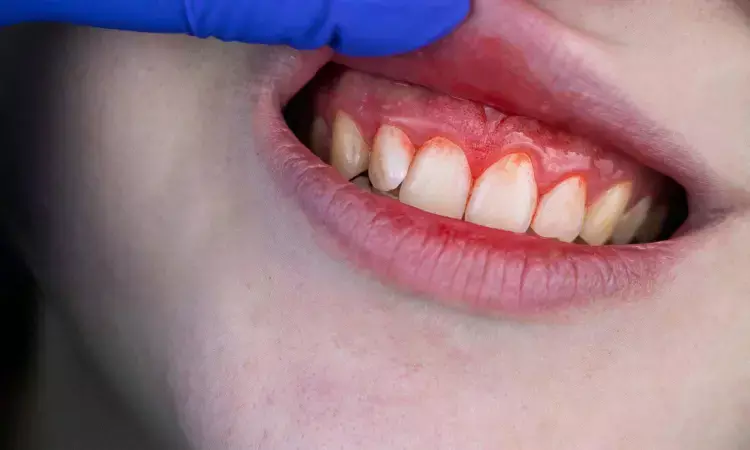- Home
- Medical news & Guidelines
- Anesthesiology
- Cardiology and CTVS
- Critical Care
- Dentistry
- Dermatology
- Diabetes and Endocrinology
- ENT
- Gastroenterology
- Medicine
- Nephrology
- Neurology
- Obstretics-Gynaecology
- Oncology
- Ophthalmology
- Orthopaedics
- Pediatrics-Neonatology
- Psychiatry
- Pulmonology
- Radiology
- Surgery
- Urology
- Laboratory Medicine
- Diet
- Nursing
- Paramedical
- Physiotherapy
- Health news
- Fact Check
- Bone Health Fact Check
- Brain Health Fact Check
- Cancer Related Fact Check
- Child Care Fact Check
- Dental and oral health fact check
- Diabetes and metabolic health fact check
- Diet and Nutrition Fact Check
- Eye and ENT Care Fact Check
- Fitness fact check
- Gut health fact check
- Heart health fact check
- Kidney health fact check
- Medical education fact check
- Men's health fact check
- Respiratory fact check
- Skin and hair care fact check
- Vaccine and Immunization fact check
- Women's health fact check
- AYUSH
- State News
- Andaman and Nicobar Islands
- Andhra Pradesh
- Arunachal Pradesh
- Assam
- Bihar
- Chandigarh
- Chattisgarh
- Dadra and Nagar Haveli
- Daman and Diu
- Delhi
- Goa
- Gujarat
- Haryana
- Himachal Pradesh
- Jammu & Kashmir
- Jharkhand
- Karnataka
- Kerala
- Ladakh
- Lakshadweep
- Madhya Pradesh
- Maharashtra
- Manipur
- Meghalaya
- Mizoram
- Nagaland
- Odisha
- Puducherry
- Punjab
- Rajasthan
- Sikkim
- Tamil Nadu
- Telangana
- Tripura
- Uttar Pradesh
- Uttrakhand
- West Bengal
- Medical Education
- Industry
Oral neutrophil Levels Identified as Potential Biomarker for Diagnosing and Grading Periodontitis: Study

Researchers have found in a new study that Oral polymorphonuclear neutrophil (oPMN) levels can help distinguish between grade B and C periodontitis and correlate with key periodontal pathogens (Pg and Pi). This indicates that they may be potentially used as a valuable biomarker for diagnosis and risk assessment of disease progression.
Oral polymorphonuclear neutrophil (oPMN) levels are potential biomarkers for differentiating between stages and grades of periodontitis.
We compared the diagnostic utility of oPMN levels with bleeding on probing percentage (BOP%) and microbial load in high-risk patients with periodontitis. Sixty-two subjects were divided into four categories based on periodontitis stage and grade: stage II periodontitis (S2P, n = 19), stage III periodontitis (S3P, n = 43), grade B periodontitis (GBP, n = 34), and grade C periodontitis (GCP, n = 28).
Clinical parameters included probing depth (PD), BOP%, and clinical attachment loss (CAL). Associations between oPMN levels and BOP% were compared to periodontitis stage and grade, and the presence of the periodontal pathogens Porphyromonas gingivalis (Pg), Treponema denticola (Td), Tannerella forsythia (Tf), Aggregatibacter actinomycetemcomitans, and Prevotella intermedia (Pi) in the gingivocrevicular fluid (GCF). Both oPMN levels and BOP% were associated with increasing stage and grade of periodontitis; however, better sensitivity, specificity, and predictive values for differentiating between GBP versus GCP were observed with oPMN. Significant positive associations were found between oPMN level and the detection of Pg and Pi. OPMN level can be used to differentiate between grade B and C periodontitis. Likewise, the presence of periodontal pathogens Pg and Pi correlated with the oPMN level. Given these findings, oPMN level may be useful as a multipurpose clinical biomarker in terms of diagnosing periodontitis and determining the risk of disease progression. Periodontitis is a serious gum disease that can lead to tooth loss and is linked to other health issues.
Currently, bleeding of the gums after probing is one method used to assess the disease activity, but this method is not always accurate. In this study, we investigated whether counting a type of immune cell called oral neutrophil found in saliva could provide a better way to detect and measure the severity of periodontitis. We examined 62 patients with different stages and grades of the disease. We found that the number of oral neutrophils was a better tool for identifying more severe cases and those at a higher risk for future breakdown than gum bleeding. We also found that higher levels of neutrophils were linked to the presence of harmful bacteria that cause periodontitis. These findings suggest that measuring oral neutrophils could be a more reliable way to diagnose and monitor periodontitis, helping dentists identify severe cases earlier and treat patients more effectively. This method could improve how we understand and manage gum disease, leading to better patient-centered outcomes.
Reference:
Prete BRJ, Barbour A, Sun C, Tenenbaum HC, Goldberg MB, Glogauer M. Prognostic utility of oral neutrophil counts in high-risk periodontitis: A retrospective study. J Periodontol. 2025; 1-14. https://doi.org/10.1002/jper.11360
Dr. Shravani Dali has completed her BDS from Pravara institute of medical sciences, loni. Following which she extensively worked in the healthcare sector for 2+ years. She has been actively involved in writing blogs in field of health and wellness. Currently she is pursuing her Masters of public health-health administration from Tata institute of social sciences. She can be contacted at editorial@medicaldialogues.in.
Dr Kamal Kant Kohli-MBBS, DTCD- a chest specialist with more than 30 years of practice and a flair for writing clinical articles, Dr Kamal Kant Kohli joined Medical Dialogues as a Chief Editor of Medical News. Besides writing articles, as an editor, he proofreads and verifies all the medical content published on Medical Dialogues including those coming from journals, studies,medical conferences,guidelines etc. Email: drkohli@medicaldialogues.in. Contact no. 011-43720751


